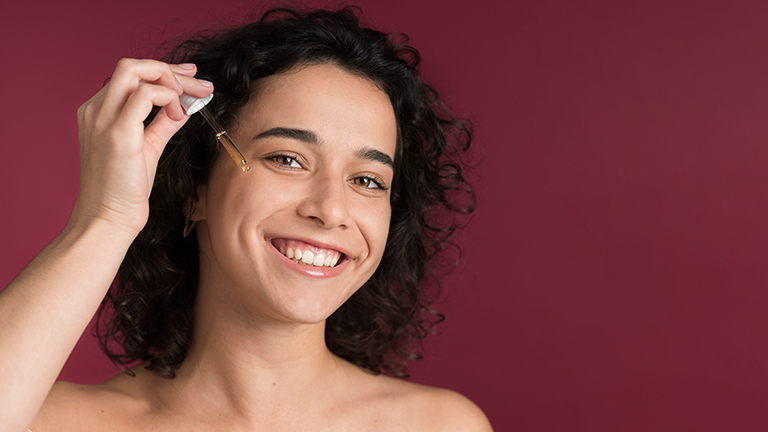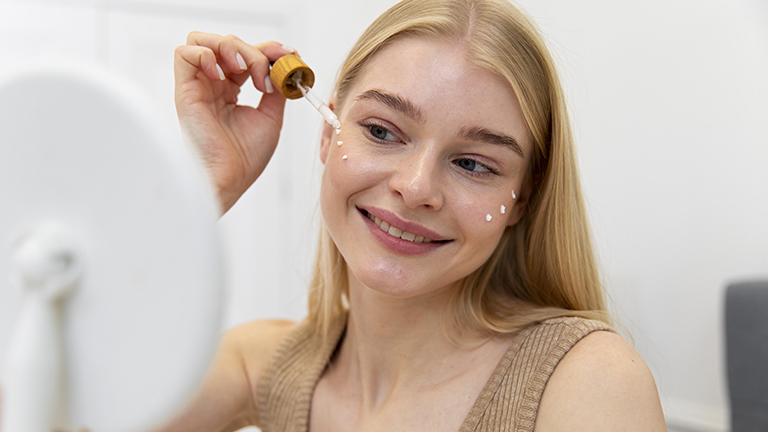Hyaluronic Acid on Face; Alright, listen up—hyaluronic acid is basically the Beyoncé of skincare right now. Every beauty junkie from LA to London’s raving about it, and honestly? For good reason. This stuff is like a tall glass of water for your face. You want dewy skin? Plumpness? That glow people write songs about? Yeah, hyaluronic acid’s your ticket.
But here’s the thing—just slapping it on isn’t enough. Nah, you gotta know the moves. Timing matters, technique matters, and there are a few rookie mistakes that’ll trip you up. So, let’s break it down. I’ll walk you through exactly how to use hyaluronic acid, when to reach for it, what not to do (seriously, don’t mess this up), and I’ll even throw in some pro tips dermatologists swear by. Let’s get your skin looking like it’s got its own soft-focus filter, shall we?
What Is Hyaluronic Acid and Why It’s Good for Your Skin
First off, this stuff isn’t some fancy lab invention. It’s already chilling in your body: your skin, your eyeballs, even your joints. What’s wild is, it’s basically a moisture magnet—can suck up water like a sponge, up to 1000 times its own weight. No joke. That’s why skin with lots of HA is all bouncy and plump, like you just got eight hours of sleep (as if).
How Hyaluronic Acid Works on the Face
Now, slapping it on your face? That’s where the magic happens. Hyaluronic acid grabs moisture from the air (and from the deeper layers of your skin) and drags it to the surface. Think of it as your skin’s personal hype man, filling in those annoying fine lines and making you look all dewy. The best serums? They’re not basic. They use different sizes of HA molecules—so some work on the surface, some dive deep. You get hydration everywhere. Science, baby.
The Science Behind Skin Hydration
Here’s the not-so-fun part: as you get older, your skin basically gets lazy at holding onto water. That’s why stuff sags, feels rough, and you start wondering when you became your mom. HA to the rescue again. Using it every day helps bring the bounce back, beefs up your skin’s barrier, and even helps your other serums (like vitamin C or niacinamide) do their thing better.
When and How to Apply Hyaluronic Acid on Face
Alright, so here’s the real scoop on slapping on hyaluronic acid (HA). Timing matters, but honestly, so does not being a total zombie about your technique. You don’t need a PhD in skincare, just a bit of common sense and, you know, not skipping steps.
Step-by-Step Guide to Applying Hyaluronic Acid
1. Wash your mug. Get all that grime, sweat, and whatever else you’ve smeared on your face off. Gentle cleanser. Don’t go at your skin like you’re sanding a floor.
2. Don’t dry off completely! This is, like, the golden rule. HA is thirsty—it grabs water like your ex grabs drama. So, leave your face a bit damp. Not dripping, just… hydrated.
3. Pop on a few drops of the serum—two, maybe three, unless you’re trying to marinate. Use your fingers, not a spatula or something weird. Massage it around—face, neck, wherever you want to glow.
4. Moisturizer, always. Don’t skip this. HA without a moisturizer is like cereal without milk—sad, dry, and honestly, kinda pointless.
5. If it’s daytime, slap on that SPF (at least 30, don’t be lazy). Sun is out to get you, and so is early aging.
Should You Use Hyaluronic Acid on Damp or Dry Skin?
Damp, always. I can’t stress this enough. If you put HA on dry skin, it’ll basically hoover up the moisture from deeper in your skin, leaving you looking like a raisin. Not cute.
How Often Should You Apply It?
Twice a day is the sweet spot—morning and night. You can layer it with pretty much anything, unless you’re doing some wild chemistry experiment with acids. Keep it simple, and your skin will thank you.
Layering Hyaluronic Acid in Your Skincare Routine
Alright, let’s cut the fluff and get to the good stuff—layering hyaluronic acid isn’t rocket science, but a lot of folks overthink it. Basically, you wanna slap that stuff on right after you wash your face, but before you drown your skin in moisturizer. Seriously, don’t wait till your face dries out—damp skin is hyaluronic acid’s BFF.
Using Hyaluronic Acid with Moisturizer
So, here’s the move: dab on your hyaluronic acid, then lock it in with a nice, thick moisturizer. I’m talking something with ceramides or peptides if you’re fancy (or just dry as a desert). That combo? Chef’s kiss for keeping your skin from flaking off like a croissant.
Combining Hyaluronic Acid with Vitamin C or Retinol
Common Mistakes to Avoid When Using Hyaluronic Acid
1. Slapping It On Dry Skin
Big mistake right there. If you smear hyaluronic acid on a bone-dry face, guess what? It starts yanking moisture out from the deeper layers of your own skin. Yeah, the stuff that’s supposed to hydrate you ends up making you feel even drier. Total backfire.
2. Forgetting the Moisturizer Step
Look, hyaluronic acid is needy. You gotta lock it in with a moisturizer, or all that juicy hydration just goes poof, straight into the air. Skip the moisturizer and your skin’s gonna feel tighter than your jeans after Thanksgiving dinner.
3. Getting a Little Too Obsessed
Chill out with the layering. Doubling up on HA serums and creams doesn’t mean double the glow—it usually just means sticky, cranky skin. One solid product is plenty. Save your money (and your face) for something else.
Choosing the Right Hyaluronic Acid Product
Here’s the thing—not all hyaluronic acid is the same, no matter what the beauty aisle wants you to believe. Picking the right one totally depends on your skin and how lazy (or extra) you feel like being with your routine.
Serum vs Cream vs Toner
- Serums? Basically a straight shot of HA, like chugging your hydration instead of sipping it.
- Creams? These are for the dry skin crew or anyone who likes their moisturizer with a side of HA—think of them as the comfort food of skincare.
- HA Toners? Kinda like giving your face a quick drink before you go all in with the heavy hitters.
What Ingredients to Look For
And if you’re squinting at ingredients lists like you’re deciphering ancient runes, here’s what actually matters: look for stuff with multi-molecular HA (that’s just code for “works in more than one way”), plus glycerin, panthenol, or ceramides. Oh, and if you spot alcohol or “fragrance” in the mix, toss it back on the shelf—those will just dry you out or make your face angry. No one needs that.
Expert Dermatologist Advice
Dr. Melissa Kane, Board-Certified Dermatologist:
Honestly? If you’re gonna slap on hyaluronic acid, do it right after you wash your face—while your skin’s still a bit damp. Don’t wait till it’s bone dry or you’re missing the point. After that, layer on a moisturizer, ‘cause that’s what actually locks in all that juicy hydration. Stick with it and, yeah, your skin barrier’s gonna get stronger and your face’ll feel smoother. Magic? Not quite, but it works.
Dr. Rahul Mehta, Cosmetic Skin Specialist:
You wanna get that glow? Try mixing hyaluronic acid with something like niacinamide or vitamin C. Suddenly your skin’s not just less dull, it’s basically lit from within. Just don’t get wild and throw it in with hardcore acids or gritty exfoliants at the same time—unless you want your face to freak out.
Dr. Clara Thompson, UK-based Aesthetic Physician:
Listen, if you live somewhere dry—think desert vibes—don’t mess around: you need a thick, heavy-duty moisturizer on top of your hyaluronic acid. Otherwise, your skin’s just gonna get thirstier. Now, if you’re sweating it out in a humid spot, go for a lighter, gel-based moisturizer so you don’t feel like an oil slick. Your climate, your rules.
Hyaluronic Acid for Anti-Aging and Skin Repair
Hyaluronic acid is a cornerstone of anti-aging skincare due to its ability to retain moisture, plump the skin, and improve elasticity. Consistent use leads to visibly smoother skin and reduced appearance of fine lines.
Boosting Collagen and Elasticity
HA indirectly supports collagen synthesis by maintaining optimal hydration levels. This prevents collagen breakdown and helps the skin remain firm over time.
Reducing Fine Lines and Wrinkles
Dehydrated skin accentuates wrinkles. Regular use of hyaluronic acid can reduce their visibility by restoring lost volume and hydration, making it one of the best non-invasive anti-aging solutions available.
Frequently Asked Questions (FAQ)
Can I slap on hyaluronic acid every day?
Yeah, go for it. Honestly, you could probably bathe in the stuff and your skin would just thank you. Twice a day? No problem. It’s super gentle—doesn’t matter if you’ve got skin like a baby seal or sandpaper, it just works.
Morning or night—when’s the sweet spot?
Why pick one? I say both. In the morning, it’s like giving your face a tall glass of water before you head out. At night, it’s more like tucking your skin in with a cozy blanket. Either way, your face is winning.
Mixing it with retinol—bad idea or genius move?
Genius move, hands down. Layer on the hyaluronic acid first so your skin has a buffer, then hit it with the retinol. It kinda softens the blow, you know? Less flaking, less looking like a molting lizard.
What if I just… stop using it?
Eh, your skin might start missing that juicy, hydrated look. You won’t shrivel up or anything, but you’ll probably notice things getting a bit duller and less bouncy. Keep it in the routine if you want that dewy vibe.
Good for oily or sensitive skin?
Yep, it’s a crowd-pleaser. Won’t clog your pores, feels light as air, and if your skin throws tantrums, it actually helps chill things out. Oily, sensitive, combination—doesn’t matter. Hyaluronic acid plays nice with everyone.
Final Thoughts – The Right Way to Use Hyaluronic Acid for Healthy, Radiant Skin
Okay, here’s the deal with hyaluronic acid: slap it on your face the right way, and you’re golden. Seriously, it can work wonders. Pro tip? Put it on while your skin’s still a bit damp—don’t let your face dry off completely after washing. Then, you gotta lock it in with a good moisturizer. Oh, and don’t just grab any random bottle off the shelf—pick one that actually makes sense for your skin type and, you know, the kind of weather you’re dealing with. Dry winter? Go thicker. Humid summer? Maybe something lighter.
Throw this stuff into your daily routine, and you’ll probably catch yourself in the mirror thinking, “Dang, I look good!” We’re talking bouncy, smooth skin with that whole natural glow. Who needs Instagram filters, anyway?
Heads up, though: I’m not a dermatologist. This is just friendly advice—if you want the serious lowdown, go ask a skin pro.


